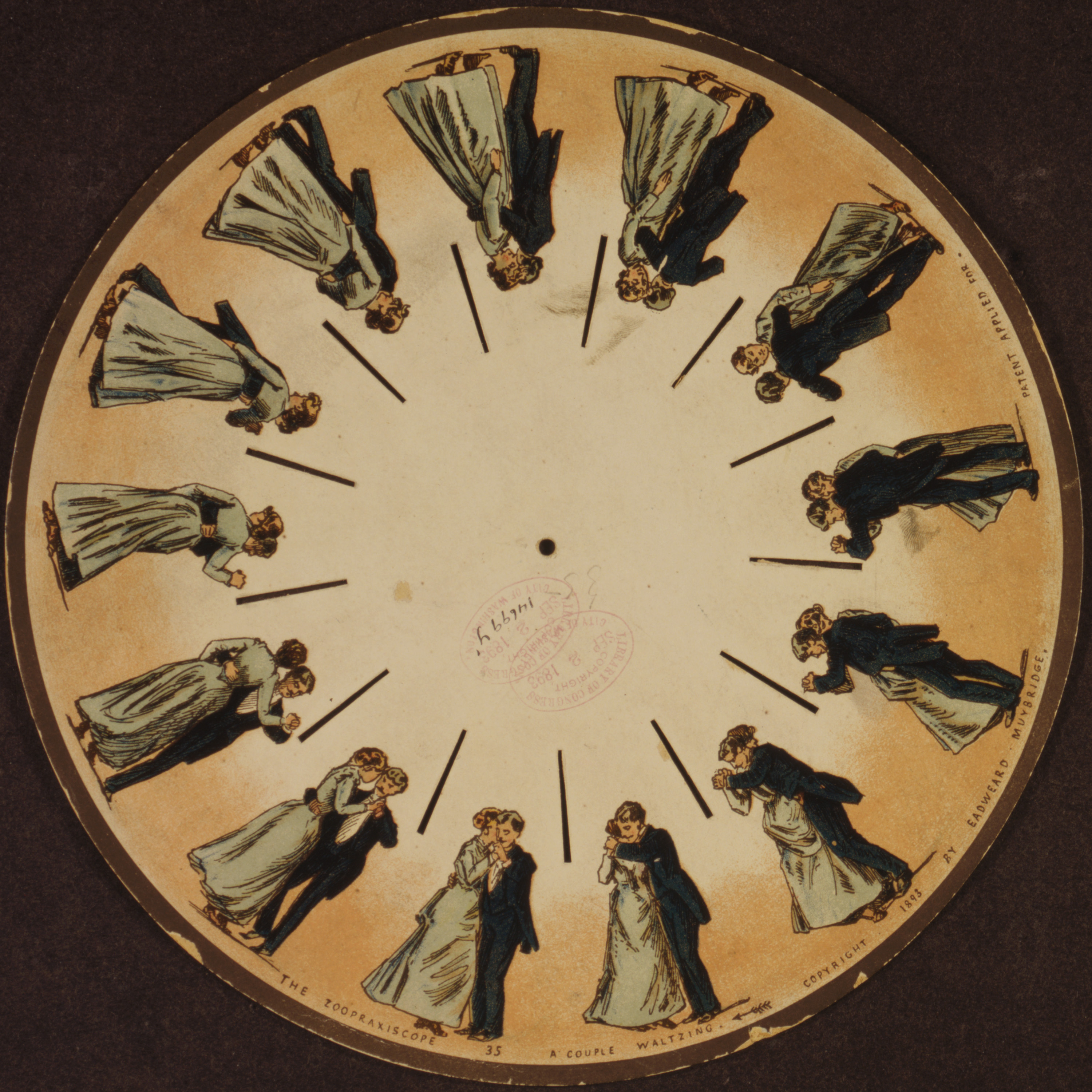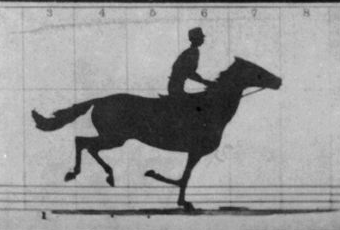 |
| Eadweard Muybridge |
Stanford and horse gaits
In 1872, the former governor of California, Leland Stanford, a businessman and race-horse owner, hired Muybridge for some photographic studies. He had taken a position on a popularly debated question of the day — whether all four feet of a horse were off the ground at the same time while trotting.
In 1872, Muybridge began experimenting with an array of 12 cameras photographing a galloping horse in a sequence of shots. His initial efforts seemed to prove that Stanford was right, but he didn’t have the process perfected. The same question had arisen about the actions of horses during a gallop. The human eye could not break down the action at the quick gaits of the trot and gallop. Up until this time, most artists painted horses at a trot with one foot always on the ground; and at a full gallop with the front legs extended forward and the hind legs extended to the rear, and all feet off the ground. Stanford sided with the assertion of "unsupported transit" in the trot and gallop, and decided to have it proven scientifically. Stanford sought out Muybridge and hired him to settle the question.
Between 1878 and 1884, Muybridge perfected his method of horses in motion, proving that they do have all four hooves off the ground during their running stride. In 1872, Muybridge settled Stanford's question with a single photographic negative showing his Standardbred trotting horse named Occident, airborne at the trot. This negative was lost, but the image survives through woodcuts made at the time (the technology for printed reproductions of photographs was still being developed). He later did additional studies, as well as improving his camera for quicker shutter speed and faster film emulsions. By 1878, spurred on by Stanford to expand the experiments, Muybridge had successfully photographed a horse at a trot; lantern slides have survived of this later work.[33] Scientific American was among the publications at the time that carried reports of Muybridge's ground-breaking images.
Stanford also wanted a study of the horse at a gallop. Muybridge planned to take a series of photographs on 15 June 1878, at Stanford's Palo Alto Stock Farm (now the campus of Stanford University). He placed numerous large glass-plate cameras in a line along the edge of the track; the shutter of each was triggered by a thread as the horse passed (in later studies he used a clockwork device to set off the shutters and capture the images). The path was lined with cloth sheets to reflect as much light as possible. He copied the images in the form of silhouettes onto a disc to be viewed in a machine he had invented, which he called a "zoopraxiscope". This device was later regarded as an early movie projector, and the process as an intermediate stage toward motion pictures or cinematography.
The study is called Sallie Gardner at a Gallop or The Horse in Motion; it shows images of the horse with all feet off the ground. This did not take place when the horse's legs were extended to the front and back, as imagined by contemporary illustrators, but when its legs were collected beneath its body as it switched from "pulling" with the front legs to "pushing" with the back legs.
Later motion studies
Muybridge often travelled back to England and Europe to publicise his work. The opening of the Transcontinental Railroad in 1869, and the development of steamships made travel much faster and less arduous than it was in 1860. On 13 March 1882 he lectured at the Royal Institution in London in front of a sell-out audience, which included members of the Royal Family, notably the future King Edward VII. He displayed his photographs on screen and showed moving pictures projected by his zoopraxiscope. |
| Eadweard Muybridge - Boys playing Leapfrog |
Muybridge and Stanford had a major falling-out concerning his research on equine locomotion. Stanford had asked his friend and horseman Dr. J. B. D. Stillman to write a book analysing The Horse in Motion, which was published in 1882. Stillman used Muybridge's photos as the basis for his 100 illustrations, and the photographer's research for the analysis, but he gave Muybridge no prominent credit. The historian Phillip Prodger later suggested that Stanford considered Muybridge as just one of his employees, and not deserving of special recognition.
However, as a result of Muybridge not being credited in the book, the Royal Society of Arts withdrew an offer to fund his stop-motion studies in photography, and refused to publish a paper he had submitted, accusing him of plagiarism. Muybridge filed a lawsuit against Stanford to gain credit, but it was dismissed out of court. However, Stillman's book did not sell as expected. Muybridge, looking elsewhere for funding, was more successful. The Royal Society later invited Muybridge back to show his work.
In the 1880s, the University of Pennsylvania sponsored Muybridge's research using banks of cameras to photograph people in a studio, and animals from the Philadelphia Zoo to study their movement. The human models, either entirely nude or very lightly clothed, were photographed against a measured grid background in a variety of action sequences, including walking up or down stairs, hammering on an anvil, carrying buckets of water, or throwing water over one another. Muybridge produced sequences showing farm, industrial, construction, and household work, military maneuvers, and everyday activities. He also photographed athletic activities such as baseball, cricket, boxing, wrestling, discus throwing, and a ballet dancer performing. Showing a single-minded dedication to scientific accuracy and artistic composition, Muybridge himself posed nude for some of the photographic sequences, such as one showing him swinging a miner's pick.
 |
| Eadweard Muybridge's phenakistoscope, 1893 |
Between 1883 and 1886, Muybridge made more than 100,000 images, working obsessively in Philadelphia under the auspices of the University of Pennsylvania. During 1884, the painter Thomas Eakins briefly worked alongside him, to learn more about the application of photography to the study of human and animal motion. Eakins later favoured the use of multiple exposures superimposed on a single photographic negative to study motion more precisely, while Muybridge continued to use multiple cameras to produce separate images which could also be projected by his zoopraxiscope.The vast majority of Muybridge's work at this time was done in a special sunlit outdoor studio, due to the bulky cameras and slow photographic emulsion speeds then available. Towards the end of this period, Muybridge spent much of his time selecting and editing his photos in preparation for publication.
In 1887, the photos were published as a massive portfolio, with 781 plates comprising 20,000 of the photographs, in a groundbreaking collection titled Animal Locomotion: an Electro-Photographic Investigation of Connective Phases of Animal Movements.Muybridge's work contributed substantially to developments in the science of biomechanics and the mechanics of athletics. Some of his books are still published today, and are used as references by artists, animators, and students of animal and human movement.
Recent scholarship has noted that in his later work, Muybridge was influenced by, and in turn influenced the French photographer Étienne-Jules Marey. In 1881, Muybridge first visited Marey's studio in France and viewed stop-motion studies before returning to the US to further his own work in the same area. Marey was a pioneer in producing multiple exposure sequential images using a rotary shutter in his so-called "Marey wheel" camera.
While Marey's scientific achievements in the realms of cardiology and aerodynamics (as well as pioneering work in photography and chronophotography) are indisputable, Muybridge's efforts were to some degree more artistic rather than scientific. As Muybridge explained, in some of his published sequences he had substituted images where original exposures had failed, in order to illustrate a representative movement (rather than producing a strictly scientific recording of a particular sequence).
Today, similar setups of carefully timed multiple cameras are used in modern special effects photography but they have the opposite goal of capturing changing camera angles, with little or no movement of the subject. This is often dubbed "bullet time" photography.
After his work at the University of Pennsylvania, Muybridge travelled widely and gave numerous lectures and demonstrations of his still photography and primitive motion picture sequences. At the Chicago World's Columbian Exposition of 1893, Muybridge presented a series of lectures on the "Science of Animal Locomotion" in the Zoopraxographical Hall, built specially for that purpose in the "Midway Plaisance" arm of the exposition. He used his zoopraxiscope to show his moving pictures to a paying public, making the Hall the first commercial movie theater.



Motion In Art: Eadweard Muybridge And His Photographic Studies Of Motion >>>>> Download Now
ReplyDelete>>>>> Download Full
Motion In Art: Eadweard Muybridge And His Photographic Studies Of Motion >>>>> Download LINK
>>>>> Download Now
Motion In Art: Eadweard Muybridge And His Photographic Studies Of Motion >>>>> Download Full
>>>>> Download LINK